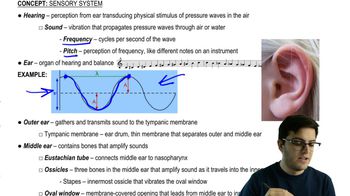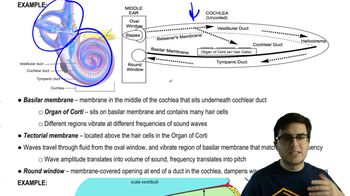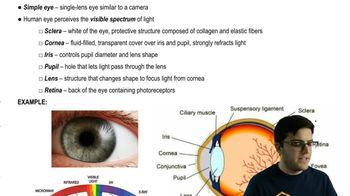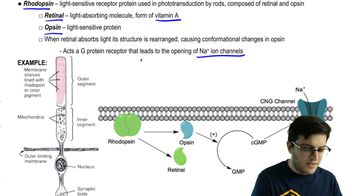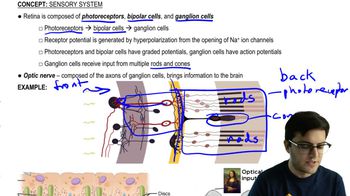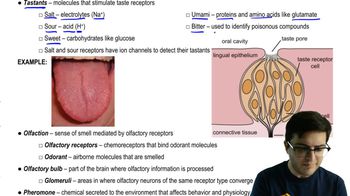Table of contents
- 1. Introduction to Biology2h 42m
- 2. Chemistry3h 40m
- 3. Water1h 26m
- 4. Biomolecules2h 23m
- 5. Cell Components2h 26m
- 6. The Membrane2h 31m
- 7. Energy and Metabolism2h 0m
- 8. Respiration2h 40m
- 9. Photosynthesis2h 49m
- 10. Cell Signaling59m
- 11. Cell Division2h 47m
- 12. Meiosis2h 0m
- 13. Mendelian Genetics4h 44m
- Introduction to Mendel's Experiments7m
- Genotype vs. Phenotype17m
- Punnett Squares13m
- Mendel's Experiments26m
- Mendel's Laws18m
- Monohybrid Crosses19m
- Test Crosses14m
- Dihybrid Crosses20m
- Punnett Square Probability26m
- Incomplete Dominance vs. Codominance20m
- Epistasis7m
- Non-Mendelian Genetics12m
- Pedigrees6m
- Autosomal Inheritance21m
- Sex-Linked Inheritance43m
- X-Inactivation9m
- 14. DNA Synthesis2h 27m
- 15. Gene Expression3h 20m
- 16. Regulation of Expression3h 31m
- Introduction to Regulation of Gene Expression13m
- Prokaryotic Gene Regulation via Operons27m
- The Lac Operon21m
- Glucose's Impact on Lac Operon25m
- The Trp Operon20m
- Review of the Lac Operon & Trp Operon11m
- Introduction to Eukaryotic Gene Regulation9m
- Eukaryotic Chromatin Modifications16m
- Eukaryotic Transcriptional Control22m
- Eukaryotic Post-Transcriptional Regulation28m
- Eukaryotic Post-Translational Regulation13m
- 17. Viruses37m
- 18. Biotechnology2h 58m
- 19. Genomics17m
- 20. Development1h 5m
- 21. Evolution3h 1m
- 22. Evolution of Populations3h 52m
- 23. Speciation1h 37m
- 24. History of Life on Earth2h 6m
- 25. Phylogeny2h 31m
- 26. Prokaryotes4h 59m
- 27. Protists1h 12m
- 28. Plants1h 22m
- 29. Fungi36m
- 30. Overview of Animals34m
- 31. Invertebrates1h 2m
- 32. Vertebrates50m
- 33. Plant Anatomy1h 3m
- 34. Vascular Plant Transport1h 2m
- 35. Soil37m
- 36. Plant Reproduction47m
- 37. Plant Sensation and Response1h 9m
- 38. Animal Form and Function1h 19m
- 39. Digestive System1h 10m
- 40. Circulatory System1h 57m
- 41. Immune System1h 12m
- 42. Osmoregulation and Excretion50m
- 43. Endocrine System1h 4m
- 44. Animal Reproduction1h 2m
- 45. Nervous System1h 55m
- 46. Sensory Systems46m
- 47. Muscle Systems23m
- 48. Ecology3h 11m
- Introduction to Ecology20m
- Biogeography14m
- Earth's Climate Patterns50m
- Introduction to Terrestrial Biomes10m
- Terrestrial Biomes: Near Equator13m
- Terrestrial Biomes: Temperate Regions10m
- Terrestrial Biomes: Northern Regions15m
- Introduction to Aquatic Biomes27m
- Freshwater Aquatic Biomes14m
- Marine Aquatic Biomes13m
- 49. Animal Behavior28m
- 50. Population Ecology3h 41m
- Introduction to Population Ecology28m
- Population Sampling Methods23m
- Life History12m
- Population Demography17m
- Factors Limiting Population Growth14m
- Introduction to Population Growth Models22m
- Linear Population Growth6m
- Exponential Population Growth29m
- Logistic Population Growth32m
- r/K Selection10m
- The Human Population22m
- 51. Community Ecology2h 46m
- Introduction to Community Ecology2m
- Introduction to Community Interactions9m
- Community Interactions: Competition (-/-)38m
- Community Interactions: Exploitation (+/-)23m
- Community Interactions: Mutualism (+/+) & Commensalism (+/0)9m
- Community Structure35m
- Community Dynamics26m
- Geographic Impact on Communities21m
- 52. Ecosystems2h 36m
- 53. Conservation Biology24m
46. Sensory Systems
Sensory System
Problem 2`
Textbook Question
The middle ear converts
a. Air pressure waves to fluid pressure waves
b. Air pressure waves to nerve impulses
c. Fluid pressure waves to nerve impulses
d. Pressure waves to hair cell movements
 Verified step by step guidance
Verified step by step guidance1
Understand the function of the middle ear: The middle ear is responsible for transmitting sound vibrations from the outer ear to the inner ear. It primarily converts air pressure waves into another form that can be processed by the inner ear.
Identify the components of the middle ear: The middle ear contains the tympanic membrane (eardrum) and three small bones known as the ossicles (malleus, incus, and stapes). These structures play a crucial role in the conversion process.
Explore the conversion process: When sound waves hit the tympanic membrane, they cause it to vibrate. These vibrations are transferred to the ossicles, which amplify the sound and convert the air pressure waves into mechanical vibrations.
Consider the role of the stapes: The stapes, the last bone in the ossicle chain, connects to the oval window of the cochlea in the inner ear. It transmits the mechanical vibrations into the cochlea, where they are converted into fluid pressure waves.
Conclude the conversion pathway: The middle ear's primary function is to convert air pressure waves into fluid pressure waves, facilitating the transmission of sound into the inner ear for further processing.
 Verified video answer for a similar problem:
Verified video answer for a similar problem:This video solution was recommended by our tutors as helpful for the problem above
Video duration:
41sPlay a video:
Was this helpful?
Key Concepts
Here are the essential concepts you must grasp in order to answer the question correctly.
Middle Ear Function
The middle ear is responsible for transmitting sound vibrations from the outer ear to the inner ear. It converts air pressure waves into mechanical vibrations using the ossicles, which are tiny bones that amplify sound. This process is crucial for hearing as it prepares the sound waves for further processing in the inner ear.
Recommended video:
Guided course

Functional Groups
Fluid Pressure Waves
Fluid pressure waves occur in the inner ear, specifically within the cochlea. When the middle ear converts air pressure waves into mechanical vibrations, these vibrations are transferred to the cochlear fluid, creating fluid pressure waves. These waves stimulate hair cells, which are essential for converting mechanical energy into nerve impulses.
Recommended video:
Guided course

Blood Pressure
Hair Cell Movements
Hair cells are sensory cells located in the cochlea of the inner ear. They play a critical role in hearing by responding to fluid pressure waves. The movement of these hair cells generates electrical signals, which are then transmitted as nerve impulses to the brain, allowing us to perceive sound. This conversion is a key step in the auditory process.
Recommended video:
Guided course
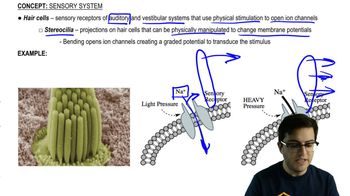
Hair Cells
Related Videos
Related Practice






